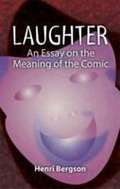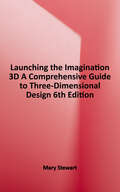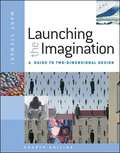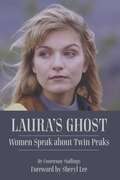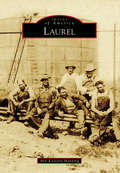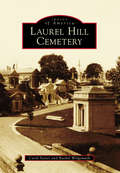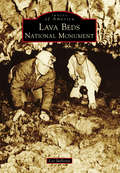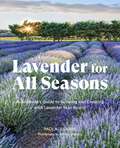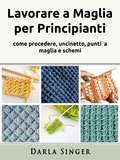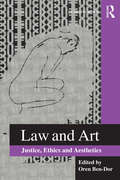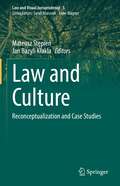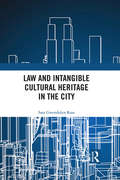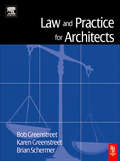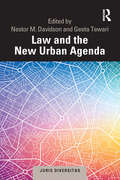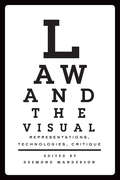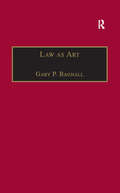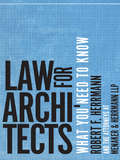- Table View
- List View
Laughter: An Essay on the Meaning of the Comic
by Henri BergsonIn this great philosophical essay, Henri Bergson explores why people laugh and what laughter means. Written at the turn of the twentieth century, Laughter explores what it is in language that makes a joke funny and what it is in us that makes us laugh. One of the functions of humor, according to Bergson, is to help us retain our humanity during an age of mechanization. Like other philosophers, novelists, poets, and humorists of his era, Bergson was concerned with the duality of man and machine. His belief in life as a vital impulse, indefinable by reason alone, informs his perception of comedy as the relief we experience upon distancing ourselves from the mechanistic and materialistic. "A situation is always comic," Bergson notes, "if it participates simultaneously in two series of events which are absolutely independent of each other, and if it can be interpreted in two quite different meanings. " The philosopher's thought-provoking insights (e. g. , "It seems that laughter needs an echo. Our laughter is always the laughter of a group. ") keep this work ever-relevant as a thesis on the principles of humor.
Launching the Imagination: A Comprehensive Guide to Basic Design
by Mary StewartLaunching the Imagination treats design as both a verb and a noun―as both a process and a product. Design is deliberate―a process of exploring multiple solutions and choosing the most promising option. Through an immersion in 2-D 3-D and 4-D concepts students are encouraged to develop methods of thinking visually that will serve them throughout their studies and careers.
Launching the Imagination: A Comprehensive Guide to Basic Design (3rd edition)
by Mary StewartDesigned for courses in Creativity, Two-, Three- or Four-Dimensional Design, Launching the Imagination offers a comprehensive framework on which students, teachers, and administrators can build. The approach in this third edition is refined, distilled, and updated, using over 600 examples drawn from traditional and contemporary sources. Interviews of artists and designers, known as Profiles, introduce students to working processes, career choices, and criteria for excellence from a remarkable group of masters. Launching the Imagination is available in a comprehensive volume treating 2D design, Creativity and Problem-solving, 3D design, and time-based (4D) design; or in split volumes containing either 2D or 3D design, plus the material on Creativity and Problem-solving. This edition of Launching the Imagination moves the content of the Core Concepts in Art CD-ROM to the Online Learning Center. With free access, this website, which engages students interactively with the elements and principles of art through numerous interactive exercises, has been re-organized and expanded.
Launching the Imagination: A Comprehensive Guide to Three-Dimensional Design
by Mary StewartDesigned for courses in creativity, two-, three- or four-dimensional design, Launching the Imagination offers a comprehensive framework on which students, teachers, and administrators can build. The approach in this third edition is refined, distilled, and updated, using over 600 examples drawn from traditional and contemporary sources. Interviews of artists and designers, known as Profiles, introduce students to working processes, career choices, and criteria for excellence from a remarkable group of masters. Launching the Imagination is available in a comprehensive volume treating 2D design, creativity and problem-solving, 3D design, and time-based (4D) design; or in split volumes containing either 2D or 3D design, plus the material on creativity and problem-solving. This edition of Launching the Imagination moves the content of the Core Concepts in Art CD-ROM to the Online Learning Center. With free access, this website engages students interactively with the elements and principles of art through numerous interactive exercises and has been reorganized and expanded.
Launching the Imagination: A Comprehensive Guide to Two-Dimensional Design
by Mary StewartNew and better than ever, Launching the Imagination treats design as both a verb and a noun - as both a process and a product. Design is deliberate - a process of exploring multiple solutions and choosing the most promising option. Through an immersion in 2-D concepts students are encouraged to develop methods of thinking visually that will serve them throughout their studies and careers.
Launching the Imagination: A Guide to Two-Dimensional Design (4th Edition)
by Mary StewartLaunching the Imagination treats design as both a verb and a noun--as both a process and a product. Through an immersion in 2-D concepts and problems, students are encouraged to develop ways of thinking visually that will serve them throughout their studies and careers. They learn that design is deliberate--a process of exploring a wide range of solutions and choosing the most promising option for further development.
Laura's Ghost: Women Speak About Twin Peaks
by Courtenay StallingsThis incredibly powerful book by media professor Courtenay Stallings explores the dark side of Twin Peaks through interviews with fans of the show who've experienced trauma in their own lives and worked through it with assistance from the character of Laura Palmer. In 1990, the groundbreaking television series Twin Peaks, cocreated by David Lynch and Mark Frost, opened with a murder mystery when a homecoming queen washed up on a rocky beach. Laura Palmer&’s character began as a plot device that triggered a small town to face its fractured self. After three seasons and a film, Laura Palmer is no longer just a plot device. Twin Peaks allows the audience to get to know the victim—a complex woman finding her strength while enduring incredible trauma. Laura&’s Ghost: Women Speak about Twin Peaks explores Laura&’s legacy through the perspectives of women in the fan community and women involved in the show. Actor Sheryl Lee examines the challenges of playing Laura Palmer. Filmmaker Jennifer Lynch discusses writing Laura&’s backstory in The Secret Diary of Laura Palmer. Grace Zabriskie argues about the complicity of Sarah Palmer, Laura&’s mother. Sabrina S. Sutherland, executive producer of Twin Peaks, talks about Laura&’s legacy. Women in the Twin Peaks fan community share their powerful and heart-wrenching stories of survival and what Laura Palmer means to them. This book is a reckoning in which women speak about trauma, mischief, humor, sexuality, strength, weakness, wickedness, and survival.
Laurel
by Ann Kooistra-ManningEarly Laurel, like many Montana frontier towns, was shaped by tenacious settlers who struggled to carve a living from a harsh, often unforgiving landscape in the wake of the Indian Wars. Laurel started as little more than a railway station and a handful of businesses serving railroad workers, farmers, and ranchers in the early 1880s. Irrigation projects soon transformed the dry, dusty prairies along the Yellowstone River near Laurel into productive farmlands. Homesteaders flocked to the valley. By 1908, Laurel had grown into a bustling shipping and servicing center for three major railroads and boasted the largest rail yard and roundhouse between Seattle and St. Paul. In the 1920s, it became a jumping-off point for tourists destined for Yellowstone Park. A decade later, Laurel staked its claim in the region's emerging oil industry when the Laurel Leaf refinery was built. This small, unassuming town has played a vital role in the development of the Yellowstone River Valley and beyond.
Laurel Hill Cemetery
by Carol Yaster Rachel WolgemuthEstablished in 1836, Philadelphia’s Laurel Hill Cemetery was one of the earliest rural cemeteries in America. The picturesque views and outstanding horticulture, along with sculptures and monuments designed by notable artists and architects—like Alexander Milne Calder, Alexander Stirling Calder, Harriet Frishmuth, John Notman, and Thomas Ustick Walter—attracted thousands of visitors. Laurel Hill became the desired place of burial for Philadelphia’s elite and the final resting place for those with last names like Widener, Wharton, Meade, and Elkins. The cemetery’s design was much admired and widely imitated, both locally and nationally. While the 20th century ushered in a steep decline for Laurel Hill, the establishment of a friends group in 1978 and the cemetery’s designation as a National Historic Landmark in 1998 signaled a transformation for the cemetery. Laurel Hill entered a new century as a revitalized and relevant institution. Once again, the cemetery is regarded as an important part of the community, a worthy destination for visitors, and a place to share in the stories of the men and women whose lives shaped both Philadelphia and the nation.
Laurelton
by Roberta Kossoff Annette Henkin LandauWhen the 13 colonies declared their independence from the British, the area of Queens that eventually became Laurelton consisted of woodlands, ponds, and farms. This rural community gained some recognition when an attempt to build an upscale housing development for wealthy New Yorkers failed, but left in its place an elegant, new Long Island Railroad Station named "Laurelton." In 1929, the stock market crash and Depression led New Yorkers to the discovery that home ownership was a thrifty alternative to renting. As Laurelton was a beautiful and safe area, real estate boomed. The neighborhood experienced a momentous ethnic change in the 1970s, and within 20 years 80 percent of Laurelton's population was Afircan American and Caribbean middle-class professionals. Laurelton is in the eighth-wealthiest council district in New York City, and its reputation for beauty and community involvement continues.
Lauren Conrad Celebrate
by Lauren ConradFrom lifestyle and fashion icon Lauren Conrad--#1 New York Times bestselling author of Lauren Conrad Style and Lauren Conrad Beauty--comes her dazzling and essential guide to entertaining, filled with an inspiring array of lifestyle tips and personal stories and lavishly illustrated with dozens of color photographs throughout.Now that Lauren Conrad has gotten everyone all dressed up and looking their most beautiful, she gives them somewhere to go in this must-have guide to entertaining. Showcasing the same approachable attitude and insight that have made her books smash bestsellers, Lauren Conrad Celebrate shows how easy it is to throw a fantastic party.Filled with lush and inspiring original four-color photos and budget friendly tips, Lauren Conrad Celebrate offers advice about the basics to make planning any type of event a breeze, including suggestions for the perfect invitations, food, drinks, decorations, and gifts. Lauren shows how to put it all together for a diverse range of events that span the calendar, from a charming Baby shower to a festive holiday party. And she packs the book with creative full-color photos and stories from her own life, including her housewarming party, and her recent bridal shower and wedding.Just as her trusted advice has inspired women to look and feel their best, now Lauren Conrad brings out the fabulous party-giver in all of us in this elegant, must-have guide.
Lava Beds National Monument
by Lee JuilleratThe region in far northeastern California encompassed by Lava Beds National Monument is often called the "Land of Burnt Out Fires." The name reflects a landscape created by fiery volcanic forces, including cataclysmic events that created more than 700 lava tube caves and an aboveground landscape shaped and fractured by lava flows and other geologic turmoil. Despite its tortured landscape, the region has also been a place of human habitation for thousands of years. Early natives traveled through the lava beds as part of their seasonal travels for food and shelter. The Modoc Indians' knowledge of that landscape, a natural lava fortress now known as Captain Jack's Stronghold, was used during the Modoc War of 1872 and 1873. Modocs, settlers, and others who followed--sheep ranchers, homesteaders, cave discoverers, tourists, spelunkers, and US Forest Service and National Park Service managers--have played prominent roles in creating the region's, and Lava Beds National Monument's, always evolving human history.
Lavender for All Seasons: A Gardener's Guide to Growing and Creating with Lavender Year-Round
by Paola LegarreAn essential guide to to the multifaceted plant, from a passionate gardener.Lavender for All Seasons covers everything you need to know about the basics of growing lavender. Inspirational crafts and recipes that follow the seasons of the year will empower readers to discover how to integrate lavender beyond the garden and into the apothecary, pantry, and crafting space. For over twenty years, gardening expert Paola Legarre has been implementing sustainable farming practices, nourishing soil life, avoiding herbicides and synthetic fertilizers, rotating plantings with cover crops, and encouraging pollinators and beneficial insects through diversified plant hedgerows, and companion planting. With Legarre as a guide, readers will discover: ·The basics of growing lavender in different zones and conditions ·Growing requirements for healthy plants, including advice on pruning, pest control, propagation, and more ·An array of the best lavender varieties including species and cultivars for cooking, essential oils, crafting, landscaping and more ·Incorporating lavender as a key pollinator plant in your garden ·How to harvest and preserve lavender flowers for multiple uses, including techniques for drying and distilling ·Enjoying the harvest with delicious recipes incorporating lavender as an essential herb in the kitchen
Lavorare a Maglia per Principianti: come procedere, uncinetto, punti a maglia e schemi
by Darla SingerTi piace a lavorare a maglia o ti piacerebbe imparare? Impara a creare bei punti a maglia in pochissimo tempo! Che tu sia in viaggio, a casa, o ovunque tu sia, puoi lavorare a maglia nel tuo temp libero. - Crea i tuoi punti in poche ore - Impara a lavorare a maglia - Impara i punti a maglia - Crea cappelli, maglioni, calzini, regali, cose per la casa e molto altro! >>> Acquista subito la tua copia
Law & Order: Special Victims Unit Unofficial Companion
by Susan Green Randee DawnThe Law & Order: Special Victims Unit Unofficial Companion is a comprehensive guide covering the first 10 seasons and includes a synopsis and an objective analysis for each episode, as well as commentaries or recollections from the people involved in crafting the one-hour tale. It goes after the heart of SVU through interviews with actors, writers, producers, casting agents, location scouts and others. The authors peek behind the scenes of the bicoastal operation, observing the progress of an entire episode shot in New York City and a script fine-tuned in Los Angeles. The book provides fascinating insight, delighting SVU devotees who love on-screen and backstage trivia. In addition, creator Dick Wolf offers readers a gripping foreword to the book.
Law and Art: Justice, Ethics and Aesthetics
by Oren Ben-DorIn engaging with the full range of 'the arts', contributors to this volume consider the relationship between law, justice, the ethical and the aesthetic. Art continually informs the ethics of a legal theory concerned to address how theoretical abstractions and concrete oppressions overlook singularity and spontaneity. Indeed, the exercise of the legal role and the scholarly understanding of legal texts were classically defined as ars iuris - an art of law - which drew on the panoply of humanist disciplines, from philology to fine art. That tradition has fallen by the wayside, particularly in the wake of modernism. But approaching art in that way risks distorting the very inexpressibility to which art is attentive and responsive, whilst remaining a custodian of its mystery. The novelty and ambition of this book, then, is to elicit, in very different ways, styles and orientations, the importance of the relationship between law and art. What can law and art bring to one another, and what can their relationship tell us about how truth relates to power? The insights presented in this collection disturb and supplement conventional accounts of justice; inaugurating new possibilities for addressing the origin of violence in our world.
Law and Culture: Reconceptualization and Case Studies (Law and Visual Jurisprudence #5)
by Mateusz Stępień Jan Bazyli KlaklaDivided into three parts, this book examines the relationship between law and culture from various perspectives, both theoretical and empirical. Part I outlines the framework for further considerations and includes new, innovative conceptualizations of two ideas that are essential to the topic of law and culture: legal culture and customary law. Both of these reappear later in the more empirically oriented chapters of Parts II and III. Part II includes chapters on the relationships between law, customs, and culture, drawing heavily on the tradition and achievements of the anthropology of law and touching on important problems of multiculturalism, legal pluralism, and cultural defense. It focuses on the more intangible meaning of culture, while Part III addresses its more material, tangible aspects and the issue of cultural production, as well as its intersection with law.
Law and Film: Critical Reflections on a Field in Motion (Discourses of Law)
by Vittoria Becci Alexia Katsiginis Edward Van DaalenThis book explores how law can be understood through film by engaging creatively with the intellectual and aesthetic dimensions of both fields.Challenged to go beyond an instrumental analysis of a law "and" film, the contributors to this book instead consider instead the need to turn to film and what this means for how we come to understand law and its absences. The chapters explore a variety of narratives, aesthetics, cinematic epistemologies and legal phenomena; from assessing law in social debates to film as legal critique, from notions of justice to contemplations on evil, and from masculine vigilantism to radical feminism. Taken together, they constitute an inspiring body of work that embodies an urgency for diverse and subversive ways to challenge law’s formalism and authority; and to think about and respond variously to law’s impotence, its disappointment, or its boredom.This book will appeal to legal scholars and students in law and the humanities, especially those with interests in aesthetics, law and literature, law and culture, law and society, and critical legal theory.
Law and Intangible Cultural Heritage in the City
by Sara Gwendolyn RossWith disappearing music venues, and arts and culture communities at constant risk of displacement in our urban centers, the preservation of intangible cultural heritage is of growing concern to global cities. This book addresses the role and protection of intangible cultural heritage in the urban context. Using the methodology of Urban Legal Anthropology, the author provides an ethnographic account of the civic effort of Toronto to become a Music City from 2014-18 in the context of redevelopment and gentrification pressures. Through this, the book elucidates the problems cities like Toronto have in equitably protecting intangible cultural heritage and what can be done to address this. It also evaluates the engagement that Toronto and other cities have had with international legal frameworks intended to protect intangible cultural heritage, as well as potential counterhegemonic uses of hegemonic legal tools. Understanding urban intangible cultural heritage and the communities of people who produce it is of importance to a range of actors, from urban developers looking to formulate livable and sustainable neighbourhoods, to city leaders looking for ways in which their city can flourish, to scholars and individuals concerned with equitability and the right to the city. This book is the beginning of a conservation about what is important for us to protect in the city for future generations beyond built structures, and the role of intangible cultural heritage in the creation of full and happy lives. The book is of interest to legal and sociolegal readers, specifically those who study cities, cultural heritage law, and legal anthropology.
Law and Practice for Architects
by Robert Greenstreet Karen Greenstreet Brian SchermerProvides a framework for understanding of the legal, contractual and procedural implication of architectural practice. The book acts as a useful aide-memoire for students and practitioners based on the premise that smooth legal administration will provide the conditions under which client relations can be constructive and good design can be achieved.
Law and the New Urban Agenda: A Comparative Perspective (Juris Diversitas)
by Nestor M. Davidson Geeta TewariThe New Urban Agenda (NUA), adopted in 2016 at the United Nations Conference on Housing and Sustainable Urban Development (Habitat III) in Quito, Ecuador, represents a globally shared understanding of the vital link between urbanization and a sustainable future. At the heart of this new vision stand a myriad of legal challenges – and opportunities – that must be confronted for the world to make good on the NUA’s promise. In response, this book, which complements and expands on the editors’ previous volumes on urban law in this series, offers a constructive and critical evaluation of the legal dimensions of the NUA. As the volume’s authors make clear, from natural disasters and resulting urban migration in Honshu and Tacloban, to innovative collaborative governance in Barcelona and Turin, to accessibility of public space for informal workers in New Delhi and Accra, and power scales among Brazil’s metropolitan regions, there is a deep urgency for thoughtful research to understand how law can be harnessed to advance the NUA’s global mission of sustainable urbanism. It thus creates a provocative and academic dialogue about the legal effects of the NUA, which will be of interest to academics and researchers with an interest in urban studies.
Law and the Visual: Transition, Transformation, Transmission
by Desmond MandersonIn Law and the Visual, leading legal theorists, art historians, and critics come together to present new work examining the intersection between legal and visual discourses. Proceeding chronologically, the volume offers leading analyses of the juncture between legal and visual culture as witnessed from the fifteenth to the twenty-first centuries. Editor Desmond Manderson provides a contextual introduction that draws out and articulates three central themes: visual representations of the law, visual technologies in the law, and aesthetic critiques of law. A ground breaking contribution to an increasingly vibrant field of inquiry, Law and the Visual will inform the debate on the relationship between legal and visual culture for years to come.
Law as Art (Applied Legal Philosophy #7)
by Gary P. BagnallLaw as Art presents a radical new legal theory, the Law as Art Hypothesis, which conceives law, not as a system of rules, but as a distinctive kind of art work. Law is differentiated as art by the Law as Compound Artistic Type Hypothesis, which uses the heuristic metaphor of the Operatic Music Drama, the most elementally complex compound art form, to develop an idea of legal art as a distinctive empowered text, supported by the arts of drama, painting, sculpture, dress-design, architecture, rhetoric and communication to form an elementally developed yet integrated unitary art work. Part I develops a new realist epistemology to support a contemporary action-type ontology of art, differentiated as art by virtue of its artistic value. Part II opens with a critical review of the arts in legal theory, before detailing the Law as Art and Law as Compound Artistic Type Hypothesis and locating them within contemporary scholarship. Legal philosophical implications are considered and there is an acronym key and glossary, bibliography and index.
Law for Architects: What You Need to Know
by Robert F. Herrmann Menaker Herrmann LlpAn essential reference for practitioners, emphasizing how legal concepts affect the process of bringing architectural vision to reality. Law for Architects: What You Need to Know guides design professionals through the daunting landscape where design and construction meet the legal system. It provides an introduction--written in clear, reader-friendly language--to issues that arise at every stage in the practice of architecture. For architects starting or building their own practice: Why do I need a written agreement with my clients? Why do I need insurance? How do I organize my firm? For seasoned architects considering retirement: How do I transfer ownership in my company? How can I benefit from the good will I helped to build? For students who want to learn more about the practicalities of starting out: Why is it important to have a license? Isn't it enough to have a degree in architecture? What are my rights as an employee? It also addresses the perennial questions that concern architects: How do I protect myself from being sued? How do I protect my intellectual property rights in my work? and much more. Law for Architects identifies the legal issues that lurk in every corner of your design practice and helps you figure out what questions you need to ask.
Law for Artists: Copyright, the obscene and all the things in between
by Blu TirohlWritten especially for professional artists and those studying the visual arts, Law for Artists is an accessible guide to those aspects of law that impact on artists and their work. It encompasses a comprehensive range of creative practices including fine art, photography, the graphic and plastic arts, animation, illustration, applied and media arts, as well as fashion, textile and product design. As one of the few academics working in this field Blu Tirohl clearly explains the legal principles - such as intellectual property, censorship, freedom of expression and criminal law - that are relevant to artists working in a range of disciplines. In order to illustrate these key concepts the book includes an engaging collection of examples of artists who have come into conflict with the law, demonstrating precisely the challenges faced by creative practitioners. The author also explores how the establishment co-opts transgressive artists; bringing about a range of contradictions that create legal inconsistencies. While the focus is primarily on UK law, the reader is also given ample information to understand how European law affects them. An entire chapter is also dedicated to the comparative study of US Law through well-known cases, ensuring students have a well-rounded knowledge of the concepts that they need to consider in a professional context. The book also provides additional resources including a list of useful websites, a glossary of key terms, as well as a list of statutes and cases. Law for Artists is an invaluable resource to professional practitioners and art graduates, as well as the academics who instruct them. This insightful publication, the first of its kind, helps introduce artists to the professional practice skills needed to ensure they are well-equipped to deal with working life.
